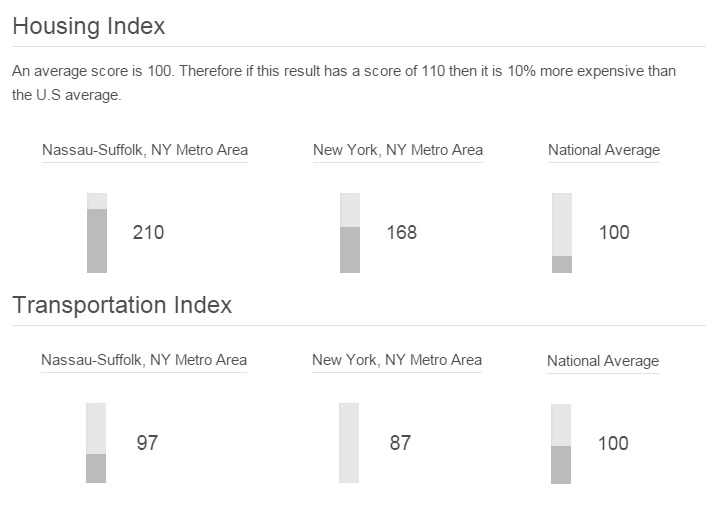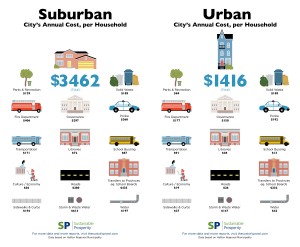 According to a recent report by “research engine” FindTheBest, the Nassau-Suffolk metro region is the nation’s most expensive place to live—a claim Long Islanders probably wouldn’t be surprised to hear. The rankings were based on a cost of living index based on six indices—housing, taxes, healthcare, childcare, transportation and “other necessities”—and while the report acknowledges that the Nassau-Suffolk metro “doesn’t have any nationwide highs for individual indices,” all six factors combined give it the top ranking.
According to a recent report by “research engine” FindTheBest, the Nassau-Suffolk metro region is the nation’s most expensive place to live—a claim Long Islanders probably wouldn’t be surprised to hear. The rankings were based on a cost of living index based on six indices—housing, taxes, healthcare, childcare, transportation and “other necessities”—and while the report acknowledges that the Nassau-Suffolk metro “doesn’t have any nationwide highs for individual indices,” all six factors combined give it the top ranking.
The study found that in the Nassau-Suffolk metro area, monthly housing costs averaged $2,029—more than twice the national average of $965, and even more costly than the New York Metro Area, which averaged $1,600—and monthly transportation costs were roughly the same as the national average at approximately $450. Considering Long Island already has the makings of an extensive, albeit disjointed, multi-modal transit network in place, this is all the more reason for Nassau and Suffolk Counties to capitalize on that network by investing in interconnectivity of transportation options and prioritizing transit-oriented development (TOD) with affordable housing components. This hefty one-two punch would reduce the monthly costs of both housing and transportation by reducing dependency on cars and suburban sprawl, making Long Island a more attractive and more affordable place for residents and visitors.

This isn’t a new idea: a 2011 plan from the Long Island Regional Economic Development Council recommends TOD as a means of maximizing transit access, generating employment opportunities and attracting younger residents, and a 2014 Destination LI study found that walkable communities where jobs and housing are located within walking distance or easily accessible by public transit were big priorities for young people—a demographic seen as crucial to Long Island’s future economy. Even developer Howard Zemsky, Governor Cuomo’s pick to head Empire State Development, recently called for local governments to prioritize attracting and retaining young people by adhering to TOD recommendations from the 2011 LIREDC plan.
While TOD may seem like a ‘cure-all’ for economic issues, smart growth requires more than a change in zoning laws. It also requires a change in mindset. Despite its proximity to New York City and the extensive transportation network already in place, Long Island’s population is highly car dependent. Suffolk County, having seen a 12.8 percent increase in zero-car households between 2009 and 2012, has a responsibility to its growing carless population, but there are still some significant hurdles yet to be overcome. Fortunately, County Executive Steve Bellone seems to have taken the 2011 LIREDC recommendations to heart and prioritized funding for downtown revitalization, bus rapid transit and Complete Streets projects in addition to championing major TOD projects like Wyandanch Rising and the Ronkonkoma Hub.
But while Suffolk is making small strides toward ditching car culture, Nassau County is farther behind. Residents want their legislators to prioritize drivers’ rights over the safety of bicyclists and pedestrians, while Oyster Bay Town Supervisor John Venditto’s tendency to oppose anything that threatens the community’s single-family home aesthetic is now posing a threat to the success of the Hicksville LIRR station redevelopment. And although Nassau County Executive Ed Mangano has enacted a countywide Complete Streets policy and expressed support for TOD projects in Mineola and Farmingdale, he has yet to embrace a multi-faceted approach to connected, walkable communities. If Nassau County wants to reduce the cost of living for existing residents while attracting more young people, county leaders should strengthen their commitment to Complete Streets and dedicate more funding for transit.

[…] Long Island’s Affordability Hinges on TOD (Mobilizing the Region) […]
To whom it concern,
Being born in 1967 in Brooklyn my parents left the city to come to Long Island for a better quality of life fast forward noticing incrementally population overload and it seems by design because I always remember Governments suggesting larger populations generate revenue, you keep repeating the same policy that never worked before. you show graphs that show how more affordable it is but what about the quality of life this is what we are trying to get away from. The only problem we have is an incompetent local government that can’t manage what they have to work with. It’s a never ending process like the way you patch a road it just never gets better. It’s real sad after loving this Island for so long and never would imagine leaving until now. Bob Matherson said it best back in the 80’s
“GET OUT OF NEW YORK BEFORE IT’S TOO LATE”
It’s almost like we are being pushed out of here to make way for a new population (just saying)
SO SAD
[…] Madeline Marvar | Mobilizing the Region […]